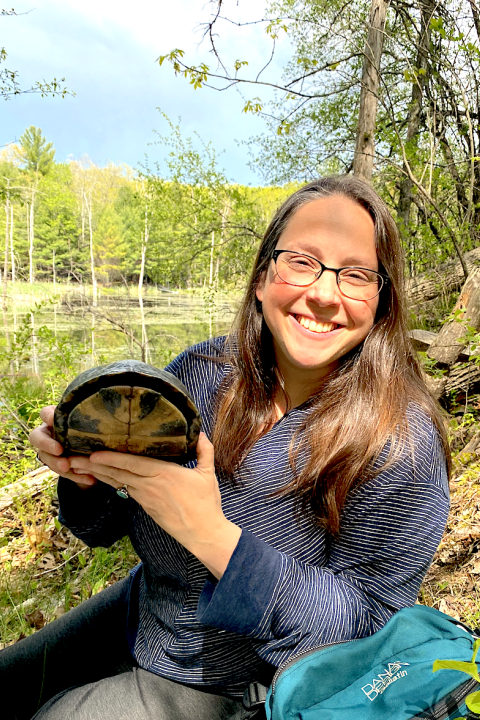
Jennifer Purrenhage
Current projects stem from long-term monitoring of salamanders and freshwater turtles in southern New Hampshire, as well as networked research through the NSF-funded Ecological Research as Education Network (EREN).
Past research includes: the effects of landscape composition on the genetic population structure of salamanders; the importance of aquatic vegetation structure in mediating biotic interactions of pond-breeding amphibians; differential growth, locomotor performance, and survival of amphibians through multiple life stages; and the importance of wetland hydroperiod and upland forest buffers for the health of vernal pool-breeding amphibian communities. By observing how populations and communities respond along environmental gradients (e.g., hydroperiod, canopy cover, urbanization), and in the presence of multiple stressors (e.g., predation pressure, pesticide exposure), we can: (1) deepen our understanding of how systems function; (2) make predictions about how communities will respond to future environmental alterations caused by global climate change and changes in land use; and (3) inform ongoing conservation efforts.
Courses Taught
- LSA 401: Scientific Resrch Exploration
- NR 417: Soph Seminar: Wildlife Bio
- NR 435: Contemporary Conservatn Issues
- NR 435/435H: Contemporary Conservatn Issues
- NR 435H: Honors/Contemp Conservatn Iss
- NR 508: Communicating Science
- NR 650: Principles Conservatn Biology
- NR 740/840: Inventory &Montoring Ecol Comm
Education
- Ph.D., Zoology, Miami University - Ohio
- M.S., Biology, University of Akron
- B.S., Wildlife Ecology; Biological Aspects of Conservation, University of Wisconsin
- Certificate, Postsecondary Education, University of Akron
Research Interests
- Communication
- Conservation Biology
- Habitat
- Herpetology
- Wildlife
- Wildlife & Habitat Management/Conservation
Selected Publications
Hettinger, A., Merkle, B. G., Schwarz, K., Bayer, S., Whalen, E., & Purrenhage, J. (2020). Human Dimensions: Communication and Engagement, Where Ecology and Human Dimensions Meet. The Bulletin of the Ecological Society of America, 101(1). doi:10.1002/bes2.1641
Thomas, S., Purrenhage, J. L., Foster, A., Loucek, J., Roeder, A., Branch, T. L., . . . Niewiarowski, P. H. (2019). Spotted salamander (Ambystoma maculatum) breeding population structure and dynamics across 20 years at a northeastern Ohio pond. In INTEGRATIVE AND COMPARATIVE BIOLOGY Vol. 59 (pp. E230). Retrieved from https://www.webofscience.com/
Davis, M. J., Purrenhage, J. L., & Boone, M. D. (2012). Elucidating Predator-Prey Interactions Using Aquatic Microcosms: Complex Effects of a Crayfish Predator, Vegetation, and Atrazine on Tadpole Survival and Behavior. JOURNAL OF HERPETOLOGY, 46(4), 527-534. doi:10.1670/10-185
Freidenfelds, N. A., Purrenhage, J. L., & Babbitt, K. J. (2011). The effects of clearcuts and forest buffer size on post-breeding emigration of adult wood frogs (Lithobates sylvaticus). FOREST ECOLOGY AND MANAGEMENT, 261(11), 2115-2122. doi:10.1016/j.foreco.2011.03.005
Greenwald, K. R., Purrenhage, J. L., & Savage, W. K. (2009). Landcover predicts isolation in Ambystoma salamanders across region and species. BIOLOGICAL CONSERVATION, 142(11), 2493-2500. doi:10.1016/j.biocon.2009.05.021
Purrenhage, J. L., & Boone, M. D. (2009). AMPHIBIAN COMMUNITY RESPONSE TO VARIATION IN HABITAT STRUCTURE AND COMPETITOR DENSITY. HERPETOLOGICA, 65(1), 14-30. doi:10.1655/08-017R1.1
Purrenhage, J. L., Niewiarowski, P. H., & Moore, F. B. -G. (2009). Population structure of spotted salamanders (Ambystoma maculatum) in a fragmented landscape. MOLECULAR ECOLOGY, 18(2), 235-247. doi:10.1111/j.1365-294X.2008.04024.x
Purrenhage, J. L., & Boone, M. D. (2005). Effects of habitat structure and competition on larval amphibian development. In INTEGRATIVE AND COMPARATIVE BIOLOGY Vol. 45 (pp. 1180). Retrieved from https://www.webofscience.com/
Purrenhage, J. L., Niewiarowski, P. H., Moore, F. B. G., & Zamudio, K. R. (2004). Regional population dynamics of spotted salamanders (Ambystoma maculatum) in a fragmented landscape. In INTEGRATIVE AND COMPARATIVE BIOLOGY Vol. 44 (pp. 626). Retrieved from https://www.webofscience.com/